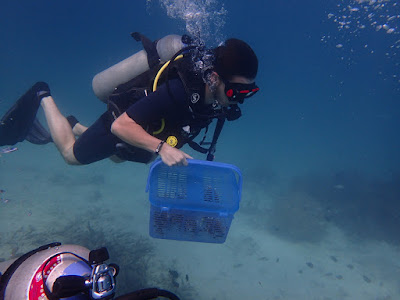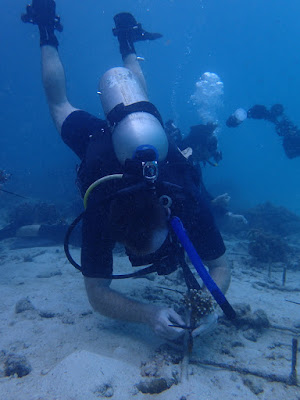At 7:00 in the morning, here come our students down the street toward the dive shop on the way to the boat.
Ajarn Wayne, Moose, Gabby, Katie, and a Thai kid who likes Chicago and Michael Jordan.
The kids going down the ramp to get on the Reef Ranger, our dive boat.
Check out the banner on the side of the boat. We'll take it underwater tomorrow for our class photo.
Off we go for more reef conservation studies.
A view of the south end of Phi Phi Don.
With dive slates in hand, Kyle and Gabby are recording each species of chaetodont they see.
Anna.
Katie.
Feather stars are echinoderms and related to starfish.
Here's a beautiful, delicate coral.
Loads of yellow snappers.
Two-spot snappers.
On the dive deck, we have a white board that is checked before we leave a dive site to be sure we have everyone on board.
After lunch, we returned to the underwater nursery. Here are marine scientists from the PMBC (Phuket Marine Biological Center) who are removing year-old corals from the racks for transplantation into a dead reef.
Here comes Kyle with a basket into which the scientists will place some coral fragments.
Katie giving the two-handed awesome sign.
Kyle now is carrying the fragments to the site on the reef where the metal frames have been placed.
We passed a beautiful reef on the way...
Here's the dead reef with metal frames positioned.
Students and instructors are all participating in this activity. They are bringing the coral fragments and other baskets containing clippers and cable ties.
Gabby is attaching a coral fragment to a metal spike using cable ties.
Annie.
Max.
Look at the fantastic buoyancy skills our students have acquired in only a few days of diving. This is why we had to spend a couple days enjoying ourselves with fun dives before we could work with corals. Buoyancy skills are critical for this work. And still, a few of our students bumped into urchin spines and rested bare legs on sea anemones. The latter use nematocysts like jellyfish, which produce a mild stinging sensation. The remedy is to pour vinegar on the affected skin.
Alyssa.
Here's a completed metal frame with coral fragments.
M - I - Z
Z - O - U
































Great to see the process of rehabilitating the dead reef. Was this reef damaged pollution or what?
ReplyDeleteAwesome video! It's also good to have the process explained. Such a great learning experience plus looks like you are having fun too. Thanks again for the updates!
ReplyDeleteWow just amazing. The reefs are so beautiful!!! So sad to see the dead reefs. Got the video to play & that was cool to see. You guys are doing such a important thing over there. Go MIZZOU!!!
ReplyDeleteLove the feather stars and I was able to open the cool video! Thanks again for posting!! I am always looking forward to the next post.
ReplyDeleteAjarn Wayne and company look like they mean business should be on the opening of a movie!
ReplyDeleteMakes my heart glad to see the restoration work. Thank you!!!
ReplyDeleteThe detailed explanation of the work you all are doing is wonderful! Such amazing pictures! The video was great! Thanks as always for the updates. Can’t wait for the next post!
ReplyDeleteThe trip just keeps getting more and more amazing! The video and all the dive photos are so beautiful. The students all seem to be doing very well with the dives. Can’t thank you enough for sharing the experiences on this blog—entertaining and educational!
ReplyDeleteJeanie Dolan
Fabulousl pictures and great information. So appreciate being able to be a part of your experience through these blogs! Love. The picture of Katie!!
ReplyDeleteIt's so inspiring to see these young adults helping the reef and the planet and having fun doing it!! Thanks for taking us on this journey with you.
ReplyDeleteGreat work. These are the pictures the university should be using for advertising! Congratulation on a wonderful job.
ReplyDelete